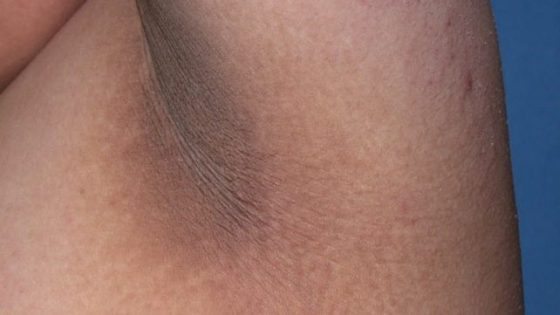Estimated reading time: 10 minutes
Polycystic ovary syndrome (PCOS) is a common disorder among women. It is characterized by menstrual irregularities, infertility, signs of androgen excess, and polycystic ovaries. It is often associated with obesity, insulin resistance, and lipid abnormalities. PCOS is the most common cause of infertility in women (1).

PCOS was first described in 1934 by Irving F. Stein and Michal L. Leventhal who described seven women with amenorrhea (failure to menstruate), male pattern hair growth (hirsutism), and enlarged ovaries containing small fluid-filled sacs (polycystic ovaries)(2).
The prevalence of PCOS varies depending on the diagnostic criteria used. It may affect 4-8 percent of women of reproductive age It is the most common endocrine abnormality of reproductive-aged women in the U.S. (1).
The exact cause of POCS is unknown. Factors that may play a role are insulin resistance which is usually associated with excess insulin, low-grade inflammation, and heredity.
The Clinical Picture
The three most common clinical features of PCOS are menstrual abnormalities, symptoms of excess androgen production (such as excess facial and body hair and acne), and polycystic ovaries. However, the clinical presentation of PCOS varies widely.
The symptoms often begin in adolescence. Menstrual abnormalities are often the first sign. However, one-third present with hirsutism (excess unwanted hair on face and body) or obesity, associated with acanthosis nigricans, a skin condition characterized by areas of dark, velvety discoloration in body folds and creases (3).
Sometimes symptoms develop later during the reproductive years, often associated with substantial weight gain.
Menstrual Abnormalities
Although menstrual abnormalities are common, approximately 30% of women with PCOS have normal menses (4).
The menstrual abnormalities in PCOS are attributed to chronic anovulation (a condition where ovulation does not occur).
The menstrual irregularities include oligomenorrhea (infrequent menstrual periods, usually less than nine menstrual periods per year) and amenorrhea (an absence of menstruation for six months or more).
Approximately 85%–90% of women with oligomenorrhea have PCOS while 30%–40% of women with amenorrhea will have PCOS (5).
Excess Androgen Production
Androgens are hormones that primarily influence the growth and development of the male reproductive system. The most active androgen is testosterone which in men is mainly produced by the testicles. Other androgens are produced mainly by the adrenal cortex, and in women by the ovaries. In healthy women, the ovaries and adrenal glands produce about 40% to 50% of the body’s testosterone (6).
Overproduction of androgens (hyperandrogenism) as occurs in women with PCOS, causes male characteristics to develop. Hyperandrogenism clinically manifests as excess body hair in a male distribution pattern. Hair is commonly seen on the upper lip, on the chin, around the nipples, and along the linea alba of the lower abdomen. Some patients have male-pattern hair loss (androgenic alopecia)(7).
Acne and seborrhea may also occur in PCOS. Seborrhea is a common skin problem. It causes a red, itchy rash and white scales. When it affects the scalp, it is called “dandruff.”
Infertility and Miscarriages
PCOS is a common cause of infertility.
However, only a subset of women with PCOS is infertile. Most can ovulate intermittently making pregnancy possible.
On the other hand, conception may take longer, and women with PCOS may have fewer children than planned. Furthermore, the rate of miscarriages is increased (8).
Mood Disorders
Women with PCOS may be more likely to have mood disorders such as depression and anxiety when compared with women without PCOS (9). These symptoms are important to recognize as they may seriously impact quality of life.
Impaired quality of life from body image concerns may cause fatigue, sleep disturbances, phobia, appetite changes, and binge eating. Consequently, it has been suggested that all women with PCOS should be screened for mood disorders. (10).

Metabolic Abnormalities in PCOS
Patients with PCOS have a high prevalence of the metabolic syndrome.
The metabolic syndrome is characterized by abdominal obesity (11), high triglyceride levels (hypertriglyceridemia) (12), low levels of HDL cholesterol (13), high blood pressure, and raised blood glucose.
Insulin Resistance, Hyperinsulinemia, and Diabetes Mellitus
The excess androgen characteristic of PCOS may be driven by an underlying insulin resistance state and hyperinsulinemia.
Insulin resistance is defined as a diminished response by cells to a given concentration of insulin (14). The pancreas responds by producing more insulin leading to high levels of insulin in the blood (hyperinsulinemia).
The pathway from insulin resistance to hyperandrogenism is often regarded as a one-way relationship. However, pathways through which excess androgen production may perpetuate insulin resistance and hyperinsulinemia may also be at play (15). Hence, insulin resistance and hyperandrogenism may assemble a vicious cycle, continuously stimulating each other in a reciprocal fashion.
Impaired glucose tolerance or overt type II diabetes develops by the age of 30 in 30–50 % of obese women with PCOS (16,17).
Obesity and Fat Distribution
Obesity is one of the typical characteristics of PCOS and is present in roughly half of all cases. In Southern Italy, where obesity is less prevalent than in the U.S. 70% of women with PCOS have increased body weight (18).
However, obesity as a disease is far from being simply a weight issue. Rather, it is a complex disorder of metabolism, abnormal energy regulation, and pathological behavior of fat tissue accompanied by inflammation, insulin resistance, and lipid abnormalities (19).
For example, patients with peripheral fat distribution have a low metabolic and cardiovascular risk, whereas patients with abdominal obesity have higher insulin levels, signs of inflammation, and increased risk of diabetes and heart disease. Most patients with PCOS exhibit an abdominal form of obesity.
Women with PCOS are predisposed to increased visceral adiposity, and this appears to be across all categories of body weight. It has been shown that subjects with PCOS have a similar percentage of total and trunk fat but a higher proportion of central abdominal fat compared with weight-matched controls (20).
Genetic Factors
Clustering of cases of PCOS in families strongly supports the role of genetic factors in the development of the disorder.
Genetic influences may set the stage for abnormally high androgen synthesis in the ovaries. The most popular model proposes a probable Mendelian pattern of inheritance, albeit with widely variable penetrance, dependent on several environmental and epigenetic factors (15).
Male and female first-degree relatives of women with PCOS are also at increased risk of developing obesity, insulin resistance, and type 2 diabetes (21,22).
The Role of Chronic Inflammation
PCOS is associated with a low-grade systemic inflammation as evidenced by elevation of markers of inflammation such as C-reactive protein (23) and interleukin 18 (24).
Chronic low-grade inflammation is also a key feature of insulin resistance, type 2 diabetes and cardiovascular disease (25).
Oxidative stress and chronic inflammation are closely inter-related. Extensive evidence supports the concept of a vicious cycle, whereby inflammation induces the generation of reactive oxygen species (ROS), while oxidative stress promotes and aggravates inflammation (26).
The vicious circle between oxidative stress and inflammation within the arterial wall may promote atherosclerosis. The same vicious circle is at play in adipose tissues where oxidative stress and inflammation impair adipocyte maturation and cell signaling.
It is presently unknown whether oxidative stress and inflammation play a causative role in PCOS, or merely reflect underlying pathogenic mechanisms typical of insulin resistance, adipocyte dysfunction, and cardiovascular disease.
PCOS and Sleep Apnea
Many women with PCOS have obstructive sleep apnea (OSA)(27).
Persons with OSA commonly experience snoring, choking or gasping during sleep, low oxygen saturation in blood, and disruption of sleep. Disrupted sleep can result in excessive daytime sleepiness, somnolence, and impaired concentration during the day (28).
Apart from adversely affecting the quality of life, OSA is strongly associated with the risk of diabetes, high blood pressure, fatty liver disease (29), atrial fibrillation (30), and cardiovascular disease.
PCOS and Cardiovascular Disease
Women with PCOS have a high prevalence of several traditional risk factors for cardiovascular disease such as lipid abnormalities, diabetes, hypertension and obesity (31).
Studies have used modalities such as carotid intima-media thickness (CIMT)(32) and coronary artery calcium (CAC) scores (33) to evaluate the presence of subclinical atherosclerosis in women with PCOS.
Studies using CIMT suggest that women with PCOS are at a greater risk of premature atherosclerosis compared with women without PCOS (34). However, data on CAC is more conflicting with one study (35) showing increased CAC among women with PCOS while another study found no difference (36).
Despite signs of early vascular changes in women with PCOS, the evidence for increased cardiovascular morbidity and mortality is limited (37). However, cardiovascular disease prevention should be a critical part of the management of women with PCOS as they constitute a high-risk group.
PCOS Diagnosis
There is not one particular test that can diagnose PCOS.
Medical history and physical examination may reveal family history and symptoms such as irregular or skipped periods, weight changes, hair changes, acne, acanthosis nigricans and central obesity.
Lab tests including blood sugar, androgen levels, and other hormones are valuable.
A sonogram may be done to evaluate the ovaries.
Treatment of PCOS
The initial treatment of PCOS usually aims at weight loss. Lifestyle intervention improves body composition, signs of androgen excess, and insulin resistance (38). Weight loss improves the endocrine profile and increases the likelihood of ovulation and pregnancy (39).
The dietary composition may be important.
A systematic review published 2013 (40) found the following:
- Greater weight loss for a monounsaturated fat-enriched diet
- Improved menstrual regularity for a low-glycemic index diet
- Increased free androgen index for a high-carbohydrate diet
- Greater reductions in insulin resistance, fibrinogen, total, and HDL cholesterol for a low-carbohydrate or low-glycemic index diet
- Improved quality of life for a low-glycemic index diet
- Improved depression and self-esteem for a high-protein diet.
- Weight loss improved the presentation of PCOS regardless of dietary composition in the majority of studies
An increase in physical activity may be beneficial and is recommended for PCOS patients (41).
The choices of treatment for women with PCOS depend on the clinical picture.
Symptoms of PCOS typically fit into three categories; menstruation-related disorders, androgen related symptoms, and infertility (42). Treatment usually aims at one or more of these categories.
Menstruation-Related Disorder
Low-dose combined hormonal contraceptives, containing estrogen and progestin, are the primary recommended treatment option for PCOS-related menstrual disorders (39).
Androgen Related Symptoms
Combined hormonal oral contraceptives are first-line for pharmacologic management of hirsutism in premenopausal women who don’t wish to become pregnant (39).
Spironolactone, an aldosterone antagonist, may act as an androgen antagonist and can be used in combination with oral contraceptives for treatment of PCOS related symptoms (39).
Metformin and thiazolidinediones have insulin-lowering effects by improving insulin sensitivity and can decrease androgen levels. Metformin is preferred at this time because it appears to have the safest risk-benefit ratio, and it can cause weight loss (39).
Weight loss can reduce androgen levels in patients with PCOS. The benefits of weight loss can be evident with a loss of 5% of initial body weight (43).
Infertility
Weight loss is recommended as first-line therapy for the management of infertility in overweight and obese women with PCOS (42).
In PCOS, anovulation associated with low follicle-stimulating hormone concentrations can be treated with medications such as clomiphene citrate, tamoxifen, aromatase inhibitors, metformin, glucocorticoids, or gonadotropins or surgically by laparoscopic ovarian drilling.
In vitro fertilization (an assisted reproductive technology (ART) commonly referred to as IVF), will remain the last option to achieve pregnancy when others fail.
The Take-Home Message
Polycystic ovary syndrome (PCOS) is a common disorder among women. It is characterized by menstrual irregularities, infertility, signs of androgen excess, and polycystic ovaries. It is often associated with obesity, insulin resistance, and lipid abnormalities.
PCOS is the most common cause of infertility in women.
The exact cause of POCS is unknown. Factors that may play a role are insulin resistance which is usually associated with excess insulin, low-grade inflammation, and heredity.
The three most common clinical features of PCOS are menstrual abnormalities, symptoms of excess androgen production (such as increased facial and body hair and acne), and polycystic ovaries.
The initial treatment of PCOS often aims at weight loss. Lifestyle intervention improves body composition, signs of androgen excess, and insulin resistance. Weight loss improves the endocrine profile and increases the likelihood of ovulation and pregnancy.
Further treatment is aimed at the three main categories of PCOS; menstruation-related disorders, androgen related symptoms, and infertility.
Discover more from Doc's Opinion
Subscribe to get the latest posts sent to your email.



We appear to have a genetic form of PCOS in our family–my mother, me, now my youngest daughter. Symptoms start in early adolescence. My daughter has severe acne, acanthosis nigricans, amenorrhea, some male pattern facial hair. She has sky high testosterone and insulin levels. But she weighs 85 lbs at age 16, so “weight loss as the first line of defense” is pretty useless advice that one endocrinologist gave her. Weight loss alone is not a cure all, all three of us experienced severe symptoms independent of body weight. But it’s an easy thing to throw out to women with PCOS and many professionals blame obese women with PCOS for “causing” it. This article is fairly well balanced but even while acknowledging that at least 30% of women with PCOS (I suspect it’s seriously under diagnosed in non-obese women) are not overweight, it pushes weight loss as a panacea. Tackling the underlying metabolic issues, that may result in weight loss for obese women with PCOS, makes much more sense.
Janknitz
The genetic aspect is indeed very important. Thanks for addressing that. I also agree that many women with PCOS don’t have any weight issues in which case recommending losing weight is pointless. Indeed there is a lot of ongoing research focusing on the underlying metabolic and endocrine abnormalities such as insulin resistance, inflammation and excess androgen production.
Thanks for sharing your thoughts.